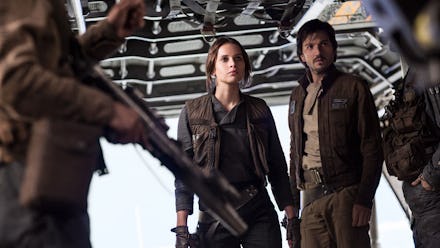'Rogue One' Review: A dark, gritty film that adds to the 'Star Wars' mythos

The promise of the Star Wars anthology films is to build upon the established canonical universe and offer new stories within them. This is a fancy way for Disney, which acquired Lucasfilm, to turn the Star Wars franchise into a Marvel-like set of properties, packaging nerdy nostalgia as an inextinguishable cash cow.
But Star Wars fans won't mind much if the qualities of these films match the originals, and Rogue One: A Star Wars Story, the first of the anthology films, is par for the course. Rogue One is directed by Gareth Edwards who, as anyone who has viewed a behind-the-scenes featurette of the film knows, is a fervent, self-professed Star Wars geek. It shows — in a good way.
Edwards' fandom doesn't drown Rogue One in nostalgia. The film achieves a delicate balance between adding to the Star Wars mythos — with marquee original trilogy cameos to be had — while standing apart in terms of scope and narrative themes.
(Editor's note: Minor spoilers for Rogue One beyond this point. You've been warned).
Rogue One is a strikingly dark film
Edwards was a curious directorial choice for Rogue One, given his claim to blockbuster fame was the ambitious-but-flawed Godzilla remake. But in hindsight, it makes a lot of sense — the Death Star is the Star Wars equivalent of a monster, a literal planet destroyer that wipes out Princess Leia's home planet Alderaan in A New Hope.
Rogue One occurs prior to the events of A New Hope, as it follows the Rebels who steal the plans to the Death Star that's ultimately destroyed in A New Hope. The Empire, then, is at the height of its power; something Rogue One isn't afraid to shy away from.
The film is notably dark, akin to The Empire Strikes Back, and parents face genuine consideration as to whether they'll want to bring their kids to a screening. There's a lot of death. Edwards won't spare you from on-screen deaths or anguish — even for nameless extras for Rebels and Imperial troops alike — in the waning moments before their destruction. Marvel's lighthearted Guardians of the Galaxy had the dubious honor of having the most deaths depicted on-screen, but already Rogue One could be staking its claim to that title.
None of this feels excessive, however, because of Rogue One's place in the Star Wars timeline and the protagonists we follow. There are no Jedi here, these are ordinary people facing a daunting adversary which dwarfs them in size and scope. Death is, unfortunately, a very real consequence of combat, which Rogue One acknowledges en masse.
It builds on the original trilogy, and answers one of Star Wars' biggest plot holes
Star Wars has a fervent fanbase — count me among them — but even the most diehard would acknowledge that the franchise is not without its flaws. For one, the reveal that Leia and Luke are twin siblings, despite George Lucas' claims, feels very last-minute given the sexual tension (and some kissing!) that occurs between them over the first two films in the original trilogy. That can never really be justified, but Rogue One does answer one of the biggest Star Wars plot holes: Why the hell does the Death Star have such a glaring weakness?
It's quite mystifying, and in reality it's a lazy and convenient plot device from Lucas for dramatic effect, when Luke blasts through a small exhaust port that blows up the entire station in A New Hope. However, Rogue One is here to tell you, that design flaw was intentional.
It appears Empire scientist Galen Erso (Mads Mikkelsen), the father of Rogue One's protagonist Jyn Erso (Felicity Jones), created this striking design flaw in part so that the Rebels would stand a chance against the Empire's ultimate weapon. While it's clearly there to cover Lucas' bases, the relationship between Galen and Jyn is such a fundamental part of the film that it doesn't feel tacked on.
Rogue One builds on the original trilogy in other ways. One instance is the subtlest nod to how things are kicked off in A New Hope, like how the Rebel Alliance decides they might need the help of an old hermit Jedi on Tatooine (and who would make that suggestion in the first place). There's similar easter eggs aplenty in Rogue One — so many, in fact, we'll need the full power of Reddit to parse through them all.
Cameos from the original trilogy are here, but it rarely feels overstuffed
Anyone who's seen a trailer for Rogue One already knew that Darth Vader was going to appear in the film, but there's many other faces from the original trilogy that will show up, ranging from tertiary antagonist roles to brief but memorable cameos.
It's rarely overstuffed, however, save for a cringe-worthy choke pun from Vader that removes all tension from an otherwise discerning sequence. Fans will be most surprised to see Grand Moff Tarkin (played by the late Peter Cushing in A New Hope) in more than his fair share of scenes, with breathtakingly lifelike (if not unsettling) CGI in his place. The CGI itself is so good, in fact, it makes a young, CGIed Anthony Hopkins in Westworld look like cheap fodder by contrast.
Obviously, some of these cameos are here for fan service more than actual plot, but that's not inherently bad. Rogue One is, at its core, a movie made for fans, directed by a fan who grew up on these films. It gives one pause when Disney has aspirations to Marvel-ize the Star Wars franchise into the 2020s, and that's still a looming concern. But Rogue One is evidence that there's still original and compelling stories to tell in a galaxy far, far away.